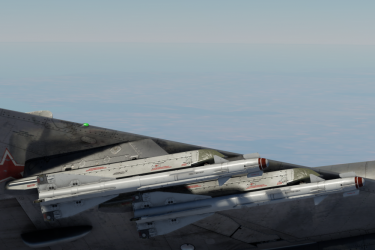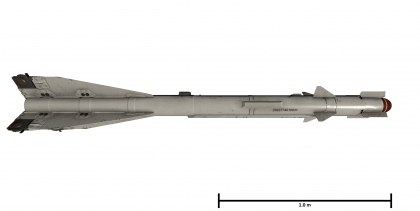Difference between revisions of "R-60"
(→Pros and cons) (Tag: Visual edit) |
(→Pros and cons) |
||
| Line 77: | Line 77: | ||
* Large seeker FOV (more prone to countermeasures such as flares, due to the increased likelihood of the countermeasures coming into view of the seeker). | * Large seeker FOV (more prone to countermeasures such as flares, due to the increased likelihood of the countermeasures coming into view of the seeker). | ||
* Lower propellant force (closer targets are more likely to avoid your missile as the missile cannot reach speeds fast enough to pull into the target). | * Lower propellant force (closer targets are more likely to avoid your missile as the missile cannot reach speeds fast enough to pull into the target). | ||
| − | * Lacking TNT load can fail to | + | * Lacking TNT load can fail to sufficiently damage targets even on close proximity |
== History == | == History == | ||
Revision as of 11:07, 7 June 2021

Contents
Description
The R-60 is a Soviet infrared homing air-to-air missile, it was introduced in Update 1.85 "Supersonic".
Vehicles equipped with this weapon
| Vehicles equipped with this weapon | |
|---|---|
| Jet fighters | MiG-21bis · ◊MiG-21MF · MiG-21SMT · MiG-23M |
| Strike aircraft | Su-17M2 · Yak-38 · Yak-38M |
| Attack helicopters | Mi-24P · ◊Mi-24P · ◄Mi-24P HFS 80 · Mi-24V |
General info
The R-60, a short range infrared homing missile, is usually most effective at ranges between 600 and 2,200 m (at sea level). The burn time of the R-60's propellant is 3 seconds. Compared to other missiles, the R-60 accelerates slower but for longer when comparing to other missiles (the AIM-9Js fuel last for 2.2 seconds with more force, R-60s having 3 seconds but with less force). The R-60s have better total-force-to-weight ratio when compared to the AIM-9Js. Comparing the AIM-9Js to the R-60s, R-60s have almost half the weight of the AIM-9Js, meaning the R-60s pulls better at lower speeds and higher altitudes.
It is also important to note that this missile can uncage its seeker which allow the user to lead the target before launching.
When compared to the AIM-9Js, the R-60s have double the inner FOV of the seeker head, meaning it is easier to acquire a lock when doing turning engagements, though this comes at the cost of being able to be fooled easier by flares and other countermeasures, since these may come into the view of the missiles (This is also the reason why AIM-9Js are less likely to be fooled by flares when compared to R-60s).
Unlike the heavier missiles (such as AIM-9Js), R-60s will be able to hit targets at extremely close ranges of up to roughly 550 m. This is all due to the very lightweight design on the missile itself.
One major problem of the R-60 is its tendency to almost always be fooled by flares. If the target has flares, even while stalling, the missile will be fooled and follow the flares anyway. It is recommended to only target unaware enemies or those without flares.
Effective damage
Due to the low explosive mass of 1.15 kg of TNT, R-60 requires closer detonation or a direct hit on a target, in order to deal sufficient damage, especially when compared to missiles such as AIM-9J which have almost 5x the explosive mass.
Comparison with analogues
Compared to the most common air-to-air missiles such as AIM-9J or R550 Magic, R-60 tends to have the upper hand in most chasing/dog fighting scenarios, due to its extended turning capability possible through the long engine burn time and high G tolerance
Usage in battles
Important details:
Every missile greatly performs better when at higher altitudes, this should be used to your advantage as missiles becomes unavoidable when launched at a reasonable range and altitude if the target doesn't deploy countermeasures, missiles accelerate faster, pull harder and reach higher velocities at higher altitudes due to the reduced drag. This comes as a double edge sword however as your missiles perform better, the enemy's missiles do as well which means that you shouldn't put yourself in a position where enemies can engage you while you're engaging a target. Coming in at unexpected angles while being undetected is the best way to utilize R-60s and every other missile.
The higher the speed of which the missile is launched, the faster the missile will reach its optimum manoeuvrability, therefore keeping your speed high and obtaining optimal launch conditions are instrumental to a successful missile kill.
Use of slaving the missile to the radar may prove to be incredibly useful when leading a target, especially when the dogfight continually changes angles and pointing the nose towards the target may not be possible.
Launching at a target flying away from you:
This is the optimum launch angle against a target. When at sea level, the maximum range in relation of yourself to the target is around 2,000 m, given that the target is flying at the same speed and same direction. This changes depending on whether the target is moving slower or faster than you. The slower the target in comparison to you, the further you can launch your missile at the target. The faster the target in comparison to you, the shorter the range is of your missile. Range is also heavily influenced by the altitude of yourself and of the target. The higher the altitude, the less drag and therefore, the higher the range is.
Launching at a target, perpendicular to you:
When the target is flying perpendicular to you, the important factors are giving your missile the optimum launch conditions to be able to pull enough Gs to hit your target. These optimum conditions include; launching your missile at a high speed (preferably above Mach), keeping enough distance between you and the target, as well as leading target as much as you can to reduce the amount of energy the missile has to use to reach the target. If the target is slower, these conditions are easier to fulfill when engaging a target. However, if the target is moving at very high speeds, such attempt at hitting the target will likely result in missing the target and greater launch conditions are required to hit the target.
Once again, higher altitudes greatly improve the performance of the missile, meaning that such angles for a missile towards the target may be impossible at lower altitudes, while being easy for the missile at higher altitudes.
Remember:
Your goal when using missiles, are to obtain the optimum launching parameters for your missile to successfully hit the target. Positioning and teamwork are instrumental to be able to obtain these launch conditions for your missiles. Using missiles to force your target into an optimum position may be necessary to launch a second missile at the target.
Pros and cons
Pros:
- Large seeker FOV (making it easier to obtain a lock without pointing the nose directly towards the target).
- Light missile (in comparison to other similar missiles, better performance at lower speeds and higher altitudes).
- Longer burn time (useful for longer range engagements).
Cons:
- Large seeker FOV (more prone to countermeasures such as flares, due to the increased likelihood of the countermeasures coming into view of the seeker).
- Lower propellant force (closer targets are more likely to avoid your missile as the missile cannot reach speeds fast enough to pull into the target).
- Lacking TNT load can fail to sufficiently damage targets even on close proximity
History
Examine the history of the creation and combat usage of the weapon in more detail than in the introduction. If the historical reference turns out to be too long, take it to a separate article, taking a link to the article about the weapon and adding a block "/History" (example: https://wiki.warthunder.com/(Weapon-name)/History) and add a link to it here using the main template. Be sure to reference text and sources by using <ref></ref>, as well as adding them at the end of the article with <references />.
Media
Excellent additions to the article would be video guides, screenshots from the game, and photos.
See also
Links to the articles on the War Thunder Wiki that you think will be useful for the reader, for example:
- reference to the article about the variant of the weapon;
- references to approximate analogues by other nations and research trees.
External links
Paste links to sources and external resources, such as:
- topic on the official game forum;
- other literature.




